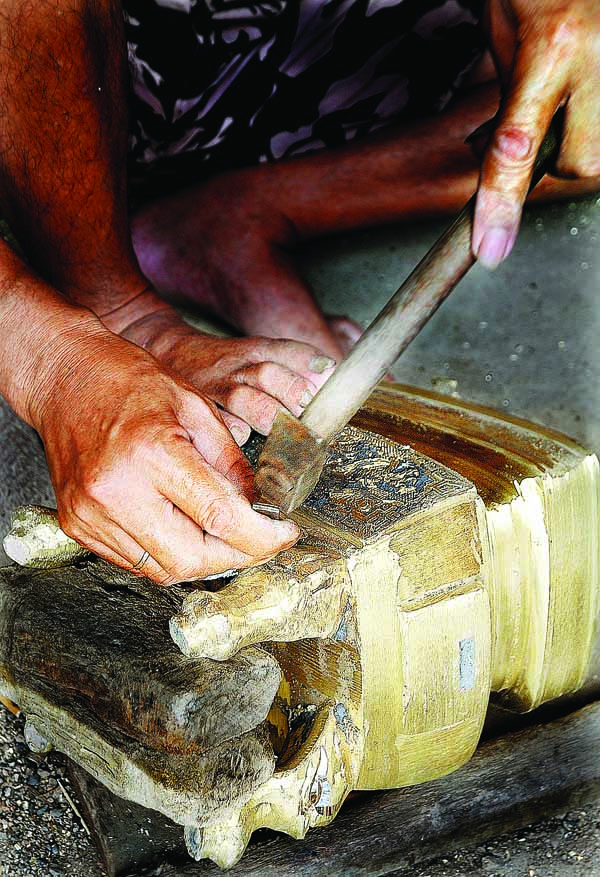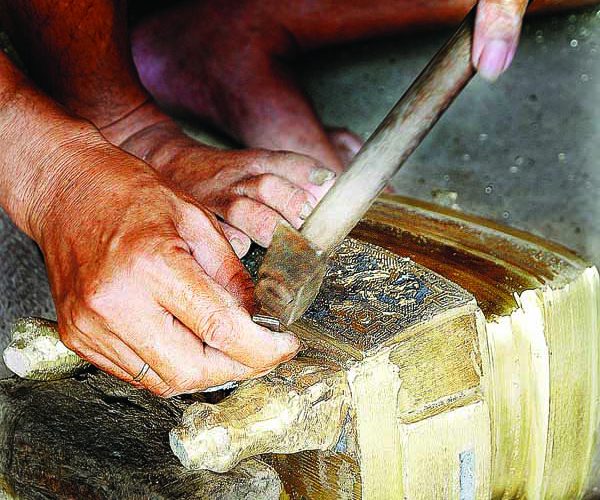(No.1, Vol.8,Feb -March Vietnam Heritage Magazine)



In the modern, boisterous and hectic Saigon everything is exposed, it seems. And yet hiding behind lustrous facades is the century-old bronze cast trade village of An Hoi in blocks 6 and 7 of commune 12, Go Vap District. The bronze-melting fire shows its red hot dance every night in the commune’s deep alleys.
Coming to these street blocks, I only saw Lego houses, just like any other street of Saigon. Foundries are nowhere to be seen. I had to ask three xe om to find the way to foundry of the most famous artisan of the village, Mr Tran Van Thang at house no. 50 of Nguyen Duy Cung Street.
Mr Thang’s 300 m2 workshop, full of clay moulds, machines and firewood in disorder, hides behind his spacious three-storey house. ‘All bronze workshops around hide behind the houses, just like mine. They used to be exposed, shaded only by the lush canopy. Since the village was urbanized, they look like they are locked behind the bars of the streets,’ the 70 year-old artisan remarked.
While we talked, a dozen workers, men and women, devotedly kneaded clay forms and drew patterns on them with sharp metal twigs. Some busied themselves with chisels and hammers, ornamenting newly cast bronze urns.
Mr Thang told me some history, ‘Late in the 19th Century, two bronze masters from Hue capital came and founded the bronze trade at Phu Lam, Cho Quan villages about 10km from here. My grandfather learned the trade there and passed it down to us.’
In the golden age from 1961 to 1975, the village had as many as 33 businesses employing over 500 workers and masters. Their products were sold all over the South and exported to Cambodia, Laos and Myanmar.
As the war ended in 1975, An Hoi Village sank into deep recession because the foundry owners had no money to buy raw material. Not until 2000-2005 did the village come back to life again. ‘Everyday people from England, France, and The Netherlands came to visit us. They loved to give a hand to our workers to make the clay moulds. Before New Year’s, traders came from everywhere, and life was festive,’ Mr Thang recalls.
Starting from 2006, the trade in An Hoi shrank again. Today, there are only five foundries left. The owner of Quoc Kien foundry, about 40m from Mr Thang’s said, ‘Many foundry owners quit because the market is flooded with industrial-made bronze urns. Our purely manual production failed to compete.’
Mr Ut, a worker of the house, described his job, ‘First the top-notch clay is dried and ground into fine powder. Then it is mixed with rice husk ash and kneaded into the urn form. The form is coated with a 5mm-thick layer of bee sap and candle wax. We carve the basic ornamental elements on the wax, plaster clay on the whole form to make a brick and bake it. The wax and sap burns out, leaving a 5mm-thick space between the core and the outer mould. We pour melted bronze into that space, leave it for several days to cool down, and then smash the inner and outer moulds to get the cast urn. The last part is filing, carving patterns and polishing.’
‘A beautiful incense set is an organic combination of skillful worker hands and years of empirical experience of a master,’ Mr Thang added.
A mandatory part of every Vietnamese family altar, each incense urn set includes an urn and two candle stands, all adorned with meticulously carved traditional patterns.

